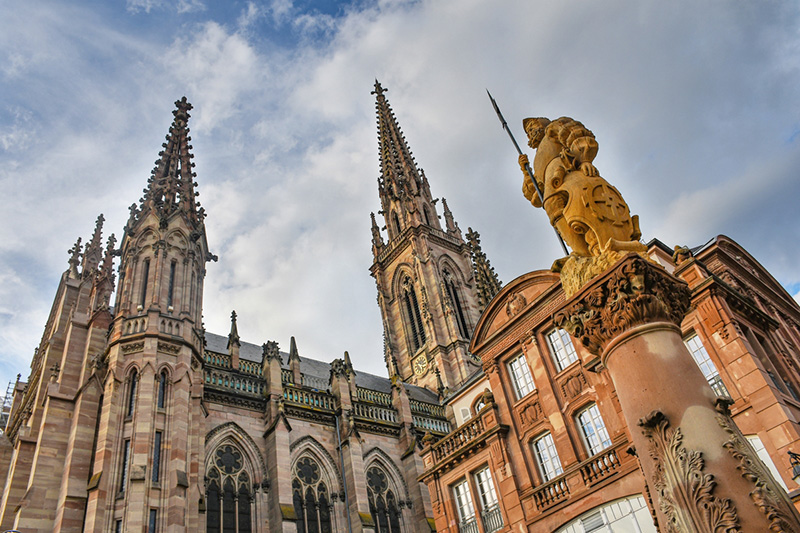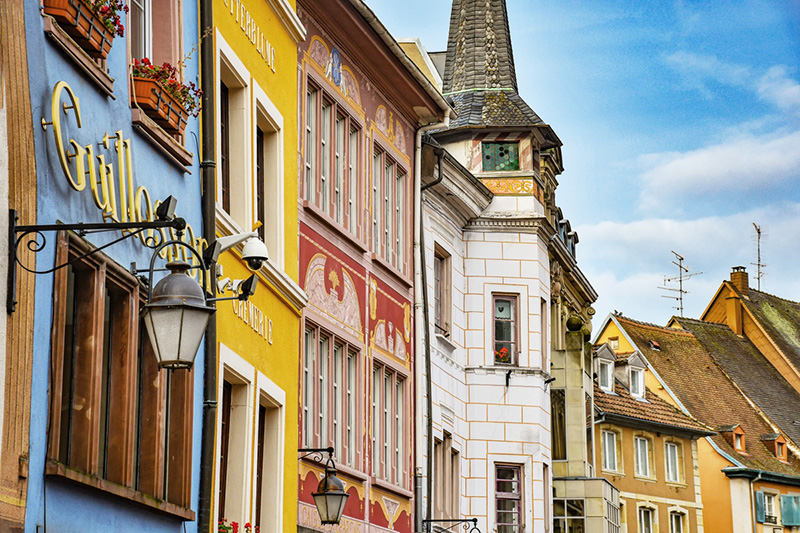When we talk about “Alsace Cities”, images of quaint streets, vibrant markets, and architectural marvels instantly flood the mind.
Having explored these magnificent cities numerous times and even calling some of them my workplace while living in Alsace, I’ve grown intimately familiar with their charms and secrets.
In this article, we’ll journey through the heart of Alsace, focusing on its bustling cities rather than the equally enchanting villages and country towns that dot the landscape.
Join me as we uncover the unique stories and attractions of Strasbourg, Sélestat, Colmar, Mulhouse, and Belfort – the jewels of Alsace that promise an unforgettable exploration.
So, grab your virtual passport as we embark on this delightful adventure through the most celebrated cities of Alsace.
About the Cities of Alsace
Nestled in the heart of Europe, the cities of Alsace are a testament to a land where two cultures blend seamlessly.
Situated mainly along the Ill River, parallel to the majestic Rhine, these Alsace cities—Strasbourg, Sélestat, Colmar, and Mulhouse—sit proudly in the Alsace plain, painting a picture of historical wealth and cultural fusion. Belfort, while slightly apart, shares the spirit that defines this region.
This strategic corridor between the Rhine and Rhône, France and Germany, has been a crossroads of human activity for centuries.
Here, the cities echo a unique duality: a blend of French charm and German efficiency of Gothic cathedrals and Renaissance houses, encapsulating a dual heritage in every cobblestone.
The Alsace cities are not just geographical entities; they are living museums, each street telling a story of peaceful coexistence and cultural exchange.
Alsace is a vibrant reminder of Europe’s capacity for diversity and unity, whether it’s the food, architecture, or languages.
5 Must-see Alsace Cities
Let’s now delve into these Alsace cities and unwrap the layers of history, gastronomy, and architecture that make the French province a mosaic of human experiences.
1. Strasbourg: The Heart of Alsace and Europe
Ah, Strasbourg! This Alsace city is a true gem, where history and modernity dance together under the watchful gaze of the majestic cathedral.

Nestled by the Ill River, Strasbourg serves as the crossroads of Europe, both geographically, culturally, and politically. It’s home to the European Parliament, making it a pivotal city on the continent.
But let’s talk about what makes Strasbourg truly special. Its streets are a canvas of architectural marvels, from the half-timbered houses in the Petite France district to the imposing Gothic cathedral of Notre Dame that dominates the skyline. Walking through Strasbourg, you’re taking a step back in time, each corner telling its own story of the past.

And the culture? Oh, it’s as rich and varied as its history. Museums abound, offering glimpses into art, history, and science. The Alsatian Museum, for instance, invites you on a journey through the region’s folk traditions, while the Modern and Contemporary Art Museum showcases the city’s forward-thinking spirit.

Strasbourg is not just a city; it’s an experience. Whether you’re sipping a local wine in a cosy winstub, getting lost in the enchanting La Petite France neighbourhood, or marvelling at the astronomical clock in the cathedral, you’re in for a treat. This city perfectly blends French charm and German efficiency, where every street and square tells a story of unity and diversity.

2. Sélestat: A Treasure Trove of History and Culture
Nestled snugly in the heart of Alsace, Sélestat might not be the first name that springs to mind when you think of Alsatian cities, but let me tell you, it’s a hidden gem full of surprises.

Known as the third richest city in Alsace regarding historical heritage, Sélestat holds its own with a quiet, dignified charm following the famous Strasbourg and Colmar.
Why, you ask? For starters, Sélestat is a book lover’s paradise. It’s home to the Humanist Library, a UNESCO World Heritage site, which houses an impressive collection of medieval manuscripts and early printed books. Imagine walking through aisles of ancient texts, each page a whisper from the past!

But it’s not just the books. The architecture in Sélestat tells tales of centuries gone by. The Gothic St. George’s Church and the Romanesque St. Foy Church stand as testaments to the city’s rich architectural heritage, inviting visitors to marvel at their beauty and the stories they hold within their ancient walls.

And let’s not forget about the culture. Sélestat might be smaller than its more famous neighbours, but it punches well above its weight in cultural offerings. From the enchanting Christmas market and the Carnival and Flowered Parades to its museums’ quiet, contemplative spaces, there’s always something to see, do, or experience.

In Sélestat, history isn’t just remembered; it’s lived. As you wander through its streets, you’ll feel a deep connection to the past, a sense of being part of a story much larger than yourself. It’s a place where history and modern life intertwine seamlessly, offering a unique glimpse into the soul of Alsace.

3. Colmar: The Quintessence of Alsatian Spirit
Colmar is the epitome of charm, with its cobblestone streets winding between colourful half-timbered houses. Often referred to as the capital of Alsatian wine, this city offers more than just exquisite drinks; it’s a feast for the eyes and the soul.

Situated in the heart of the Alsace wine region, Colmar is like stepping into a storybook. Alsace is renowned for its well-preserved old town and the enchanting “Little Venice” district, where picturesque canals reflect the pastel-coloured buildings and the sky above. Spending hours meandering through the narrow lanes is easy, each turn revealing another breathtaking view.

History buffs will be in heaven in Colmar. The former Decapolis city boasts a rich historical tapestry, with landmarks such as the Unterlinden Museum, which houses the Isenheim Altarpiece, an exemplar of Renaissance art. Meanwhile, the Bartholdi Museum celebrates the life and works of Auguste Bartholdi, the Colmar-born sculptor famous for designing the Statue of Liberty.

But Colmar’s allure isn’t just in its buildings and museums; it’s in the air. The city hosts an array of festivals throughout the year, from wine fairs to Christmas markets, each showcasing Alsace’s vibrant culture and traditions. The atmosphere during these times is electric, a testament to the city’s love for celebration and community.

In Colmar, every corner tells a story, every building holds a piece of history, and every glass of wine is a reminder of the region’s rich viticultural heritage. It’s a place where the past and present coexist beautifully, inviting visitors to lose themselves in the unique blend of French and German cultures that defines Alsace.

4. Mulhouse: The Industrial Heartbeat of Alsace
Mulhouse stands apart in the Alsace region, where the Industrial Revolution left an indelible mark, transforming it into a hub of innovation and activity. Unlike its neighbours, Mulhouse’s charm lies not in medieval streets or vineyard-laden hills but in its proud industrial heritage and vibrant cultural scene.

Situated at the crossroads of France, Germany, and Switzerland, the Alsace city of Mulhouse has long been a melting pot of cultures, reflected in its dynamic, diverse community. This city doesn’t just dwell on its past; it celebrates it, especially in its world-renowned museums. The Cité de l’Automobile, home to the world’s largest collection of vintage cars, and the Cité du Train, Europe’s largest railway museum, are testaments to Mulhouse’s love affair with the industry.

But Mulhouse isn’t all gears and engines. The city’s centre is sprinkled with colourful buildings, and the Place de la Réunion is a picturesque square that showcases the city’s architectural elegance, blending Germanic influences with French flair. Here, the Temple Saint-Étienne stands tall, offering a peaceful retreat from the bustling city life.

The cultural tapestry of Mulhouse is rich and varied. From the vibrant fabric designs of the Musée de l’Impression sur Étoffes to the lively markets that fill the air with the scent of spices and fresh produce, there’s always something to stir the senses. The city’s calendar is packed with events celebrating its industrial roots and diverse culture, bringing together people from all walks of life.

In Mulhouse, innovation and tradition blend seamlessly, creating a city that’s forward-looking yet deeply rooted in its unique heritage. It’s a place where the past is not just remembered; it’s a source of inspiration for the future, making Mulhouse a fascinating stop in the Alsace region, where every visit uncovers something new.

5. Belfort
While Belfort may not lie within the administrative bounds of modern Alsace, its soul is unmistakably Alsatian. This city, cradled in the shadow of the Vosges Mountains, has witnessed the ebb and flow of history, standing as a sentinel at the crossroads of France and Germany.

Belfort’s strategic significance is embodied by the imposing Lion of Belfort, a monumental sculpture symbolising the city’s resilience and courage during the Siege of Belfort in the Franco-Prussian War. This lion not only guards the city but also serves as a reminder of Belfort’s enduring spirit.

The city’s architecture, especially in the Vieille-ville (old town), echoes the Alsatian influence, with charming, colourful buildings and narrow streets that hark back to a shared heritage with its Alsace neighbours. It’s a place where history is carved into the very stones, telling tales of battles fought and cultures merged.

Belfort’s fortifications, designed by the famous military engineer Vauban, offer a fascinating glimpse into the past. Visitors can explore the ramparts and citadel, where each stone seems to whisper secrets of bygone eras. These historic defences showcase Belfort’s military importance and offer breathtaking views of the surrounding landscape.

Despite its martial past, Belfort is a vibrant, welcoming city today. It hosts the annual FIMU music festival, drawing artists and audiences from around the globe and turning the city into a melting pot of musical genres and cultures. It’s a testament to Belfort’s ability to transform adversity into a celebration of diversity and unity.
In Belfort, the past and present converge in a beautiful mosaic of culture, history, and architecture. Though technically outside Alsace’s borders, its heart beats in unison with the Alsatian spirit, making it an integral part of the region’s rich tapestry.

Embracing the Heart of Alsace and Beyond
From the vibrant streets of Strasbourg to the industrial heartbeat of Mulhouse and extending to the resilient spirit of Belfort, our journey through the 5 Alsace cities encapsulates the essence of the French province and its borderlands. Each city, with its unique charm, tells a part of the grand narrative of Alsace. They stand as testaments to the region’s rich cultural tapestry, blending history, architecture, and the zest for life into a captivating story.

Exploring these Alsace cities is more than a journey through picturesque landscapes; it’s an immersion into the soul of a region defined by its diversity, resilience, and the warmth of its people. Alsace, with its cities and towns, invites us to discover diversity’s beauty, unity’s strength, and joy in every shared moment.
As we conclude our exploration, we’re reminded that the Alsace and its cities are not just destinations on a map. They are experiences, memories, and lessons in living harmoniously, embracing both the past and the future. Whether you’re drawn by the allure of its historic streets, the vibrancy of its cultural festivals, or simply the charm of its daily life, Alsace waits to offer you a piece of its heart.
May this journey inspire you to explore, learn, and cherish the diverse beauty that our world holds, one Alsatian city at a time.

